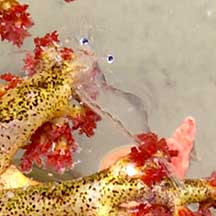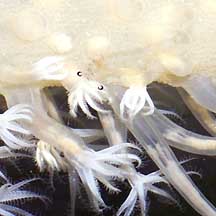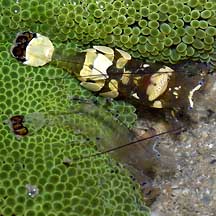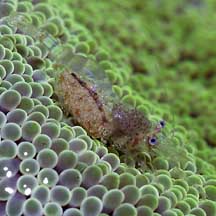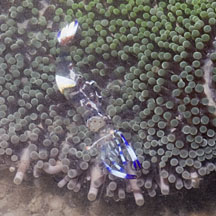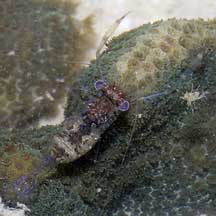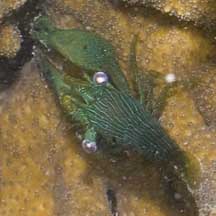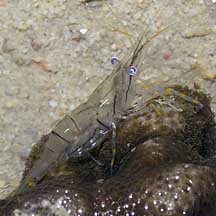Palaemonid shrimps
Family Palaemonidae
updated
Jan 2020
What
are Palaemonid shrimps? Palaemonid shrimps are crustaceans that belong
to Family Palaemonidae.
Features: This family is large and includes a wide range of shimps found in a wide range of habitats. On our shores, these include tiny (1-3cm) shrimps seen living on other animals such as sea anemones,
sea cucumbers, feather stars, and hard and soft corals. Some are also seen in small
groups on the ground and among seaweeds. These shrimps are hard to
spot as they are small and transparent; and usually only active at
night and when their host is submerged. |
| Some Palaemonid
shrimps on Singapore shores |
Family Palaeomonidae recorded for Singapore
from
Wee Y.C. and Peter K. L. Ng. 1994. A First Look at Biodiversity
in Singapore.
in red are those listed among the threatened
animals of Singapore from Davison, G.W. H. and P. K.
L. Ng and Ho Hua Chew, 2008. The Singapore Red Data Book: Threatened
plants and animals of Singapore
^from WORMS
++from The Biodiversity of Singapore, Lee Kong Chian Natural History Museum.
+Other additions (Singapore Biodiversity Record, etc)
| |
Glass and commensal
shrimps commonly seen awaiting identification
Species are difficult to positively identify without close
examination.
On this website, they are grouped by external features for convenience
of display. |
| |
Family
Palaemonidae (includes some freshwater species) |
| |
Anchistus
custos
++Anchistus custoides
Anchistus miersi
^Ancylomenes aesopius=Periclimenes aesopius
++Ancylocaris brevicarpalis= Periclimenes brevicarpalis (Peacock-tail anemone shrimp)
+Ancylomenes holthuisi ('Gelek'
anemone shrimp)=Periclimenes holthuisi
++Brucecaris tenuis (commensal with feather stars)
Conchodytes monodactylus
++Conchodytes placunae
Coralliocaris graminea (Machine
gun shrimp)
++Cristimenes commensalis (commensal with feather stars)
++Cristimenes cristimanus=Periclimenes cristimanus (Black
urchin shrimp) (VU: Vulnerable)
^Cuapetes amymone=Periclimenes amymone
^Cuapetes calmani=Periclimenes calmani
^Cuapetes elegans=Periclimenes elegans
^Cuapetes grandis=Periclimenes grandis
^Cuapetes
johnsoni (Seagrass shrimp)=*Periclimenes johnsoni (VU: Vulnerable)
++Cuapetes platycheles
++Cuapetes seychellensis
++Dasycaris zanzibarica
++Hamodactylus noumeae
Harpiliopsis beaupresii
++Harpilius consobrinus
^Harpilius lutescens=Periclimenes lutescens
++Ischnopontonia lophos
Leander tenuicornis
++Leandrites celebensis
Macrobrachium idae (NE:
Presumed nationally extinct)
Macrobrachium latidactylus (NE:
Presumed nationally extinct)
++Macrobrachium malayanum=Macrobrachium geron
Macrobrachium neglectum
++Macrobrachium nipponense
Macrobrachium pilimanus
Macrobrachium platycheles (CR: Critically endangered)
Macrobrachium rosenbergii(Udang
galah) (NE: Presumed nationally extinct)
Macrobrachium scabriculum
++Macrobrachium sundaicum
Macrobrachium trompii
++Manipontonia paeneglabra
++Manipontonia psamathe
*Palaemon sp. (Glass shrimp)
++Palaemon semmelinkii
++Palaemon serrifer
++Palaemon aff. sewelli
++Palaemonella lata
Palaemonella pottsi
++Palaemonella rotumana=Palaemonella vetigialis
++Paraclimenaeus michaeli
Periclimenaeus tridentatus
^Periclimenella spinifera=Periclimenes spiniferus
Periclimenes brooki
++Periclimenes incertus
++Periclimenes kempi
++Periclimenes cf. obscurus
Periclimenes parvus
Periclimenes sechellensis
Periclimenes suvaensis
++Philarius gerlachei
++Phycomenes sulcatus
++Pontonides loloata
++Pontoniopsis comanthi
++Urocaridella antonbruuni
^Urocaridella urocaridella=Leander urocaridella
++Vir philippinensis |
|
Links
References
- Toh Chay Hoon. 20 December 2013. Shrimps and saddleback anemonefish on carpet anemone off Pulau Hantu: Holthuis’s anemone shrimp, Periclimenes holthuisi and Saddleback anemonefish, Amphiprion polymnus. Singapore Biodiversity Records 2013: 126-127.
- Chou, L.
M., 1998. A Guide to the Coral Reef Life of Singapore.
Singapore Science Centre. 128 pages.
- Lim, S.,
P. Ng, L. Tan, & W. Y. Chin, 1994. Rhythm of the Sea: The Life
and Times of Labrador Beach. Division of Biology, School of
Science, Nanyang Technological University & Department of Zoology,
the National University of Singapore. 160 pp.
- Wee Y.C.
and Peter K. L. Ng. 1994. A First Look at Biodiversity in Singapore.
National Council on the Environment. 163pp.
- Davison,
G.W. H. and P. K. L. Ng and Ho Hua Chew, 2008. The Singapore
Red Data Book: Threatened plants and animals of Singapore.
Nature Society (Singapore). 285 pp.
- Debelius,
Helmut, 2001. Crustacea
Guide of the World: Atlantic Ocean, Indian Ocean, Pacific Ocean
IKAN-Unterwasserachiv, Frankfurt. 321 pp.
- Miyake, Sadayoshi,
and Takahiro Fujino. "Pontoniid
shrimps from the Palau Islands (Crustacea, Decapoda, Palaemonidae)."
Journal of the Faculty of Agriculture, Kyushu University 14.3
(1968): 399-431.
|
|
|

